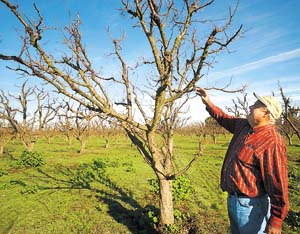
An unusually warm winter has some local fruit and nut growers
concerned about next year’s harvest because many trees need cold
weather in order to bloom suitably.
Hollister – An unusually warm winter has some local fruit and nut growers concerned about next year’s harvest because many trees need cold weather in order to bloom suitably.
Almost all trees that loose their leaves, such as apricot and walnut trees, require a “chilling period” in order to prepare their buds for bloom in the spring. Chill is measured in terms of the number of hours that the temperature is below 45 degrees, said Bill Coates, a researcher with the University of California Cooperative Extension in San Benito County. The number of hours this year is far too low and has some growers concerned that next year’s harvest could be cut in half.
“We’ve already passed the best chilling months,” Coates said, referring to November, December and part of January. “And I don’t think we’re going to get much more cold weather.”
A low, or bad, chill year can make a big difference when it comes to profits and yields, local walnut grower Paul Hain said.
“A good chill year helps all the trees bloom at about the same time, helps with pollination and eventually with harvest,” he said. “A good chill year versus a bad chill year can be a 30, 40 or 50 percent difference in yield – it can have a huge impact.”
Fruits and nuts are big business in San Benito County. Area growers produced more than $6.6 million in apples, apricots, cherries and walnuts in 2004, according to the annual crop report. A bad chill year could put a sizable dent profits next year, and Coates said some growers are becoming concerned about the warm winter temperatures.
“I’m already getting calls asking about the chilling situation,” he said. “It’s been a warm winter all over California.”
But Hain, who is also the president of the San Benito County Farm Bureau, hasn’t started to worry about his crop yet.
“Walnut trees need about 800 hours of chill and it hasn’t been a real good chill year,” Hain said. “But we still have all of January and February.”
San Benito County usually gets between 600 and 1,000 hours of chill between Nov. 1 and Feb. 28, but so far the county has only had 310 hours of chill, Coates said.
“In general, we’re not very happy when we have one of these low chilling years,” he said. “It makes it more difficult to time harvests or it could require multiple harvests, which cost more money.”
Although apple trees are also deciduous, which means they lose their leaves, Ken Perry, co-owner of B&P Orchards, isn’t worried about the warm weather.
“It’s not a concern yet,” he said. “It doesn’t affect apples as much as other fruits – but the apricot and cherry guys are probably concerned.”
Apricots are one of the most sensitive fruits in terms of chill hours, said Gary Gonzales, owner of Gonzales Orchards located just outside of Hollister.
“Apricots are hard to grow well,” he said. “And it’s such an odd-ball year in terms of weather – it was very bad.”
Although it hasn’t been cold for an extended period of time yet, Gonzales isn’t giving up hope. However, he said it is still too early to predict what, if any, impact the warm weather could have on next year’s apricot harvest.
“There’s no question about it – there hasn’t been enough chill,” he said. “But the buds actually look OK right now – and we can still catch up (on chill hours).”
Brett Rowland covers public safety and agriculture for the Free Lance. He can be reached at 831-637-5566 ext. 330 or br******@***********ws.com.









